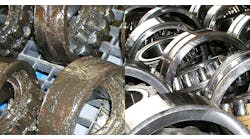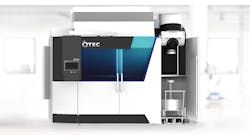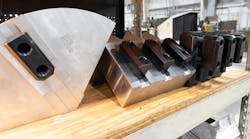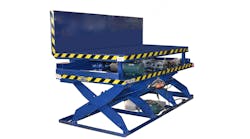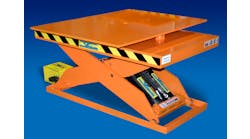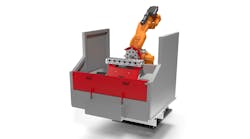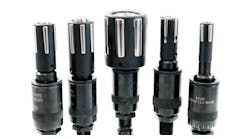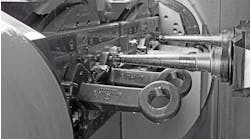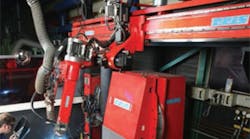Robots designated for duty in a forging operation, like ABB Robotics’ IRB 6400, will be specially outfitted for severe duty to make it more resistant to heat, shock, and other atmospheric conditions.
It’s not hard to understand the advantages of robots in manufacturing. Automation takes the place of human workers in positions that are too dangerous or too confined for personal safety, and they perform with greater reliability and continuity, so productivity increases. From that, it’s not hard to imagine how to put a robot to work in a forging operation.
There is a typical robotic installation on a drop forging line producing truck wheel hubs for Buderus Edelstahl Schmiedetechnik. The German forger adopted 10 Kuka Robotics severe-duty robots to endure temperatures nearing 2,300°F, and to operate with repeatability despite confined, high-temperature environment. The robots are also flexible enough to handle different product shapes or process schedules. Nine of the KR 210 six-axis robots manage the forging process: they unload blanks delivered from a billet sawing line; place them on a furnace conveyor; load and unload the preforming press; transfer the preforms to a blocking die, and then a finishing die; and, finally, place the forged pieces in a trim press. The trim press is unloaded by a robot, too, which places the finished forgings on a cooling line.
The tenth robot handles die spraying for the drop forge press. All robotic activity is pre-programmed for optimal reliability, and all of it is monitored in real time. The robots’ controllers communicate with the plantwide network, so individual settings may be adjusted without slowing production.
The KR 210 is among a class of “heavy payload” robots that fit the image of a forging operation. It easily picks up and handles objects weighing up to 210 kg (almost 500 lb) and its jointed arm has a reach of 2,700 mm (more than 8.5 ft.)\
A similar robotic installation was developed for Southwest Steel Processing in Newport, AR, by Girard Engineering. It engineered the process in which one robot takes a heated billet from an induction furnace and places it in the forging press. Once the forming process is done, a second robot removes the part and places it in a trim press. A third robot handles the workpiece while it’s in the trim press, and places the trimmed pieces on a conveyor. A fourth robot was supplied to handle die-spraying tasks.
In this case the severe-duty robot specified was ABB Robotics’ IRB 6400. This is another heavily engineered design, handling loads up to 450 lb, with a reach of 9 ft. The arms are mechanically balanced and equipped with double bearings, all of it enhanced with ABB’s Foundry Plus package that ensures the entire assemblage is protected against heat, pressure, and incursion from steam and particulates.
All this proves that forgers understand a role for robots in their operation. According to FORGING’s Business Outlook survey, 22% of respondents plan to install new robots and/or manipulators during 2012. That will be a significant level of investment, but considering that 60% of all respondents plan to invest in new equipment next year, it’s possible that forgers are overlooking some robotic opportunities.
Jerry Osborn, vice president and general manager of Rimrock Corp., which develops and integrates installations with ABB Robotics equipment, believes there is potential for much greater application of robots in forging operations, in particular for die spraying. While Rimrock has placed numerous robots in forging shops, he also observed that it is “traditionally an ‘under-automated’ industry’.” He allowed that the producers of large-dimension forgings may not have as many options for automating workpiece handling, because the size and weight of their products may exceed even the largest robots, but he added that “it’s still pretty tough to spray those large dies.” He noted that a robot can endure the heat and stress of working close to the press, and apply the lubricant with greater speed and effectiveness than a worker with a long nozzle trying to spray the die between each cycle.
Die spraying is an important aspect of Rimrock’s forging portfolio. In addition to robots, such installations cover the spray nozzles, spray guns, and reciprocators involved in cooling and coating the dies. The robot’s end-of-arm tooling can be customized to the task and matched to the forging die. Programming a robot for the task is made simpler because most dies are designed with a standard center-point.
Welding is another standard process in forging shops, in order to repair damaged dies. Robotic welding is widely adopted in many industries, of course, and all robotics suppliers develop automated welding systems. Reis Robotics develops robotic cells and installations for all standard welding methods, including a power source, torch system, positioners, fixtures, and the control system. Designing an installation involves more than choosing and coordinating the equipment, and includes optimizing the process parameters (weld current, voltage, wire feed, gas mixture, etc.)
The control system that Reis developed monitors a robot’s functions and the deposition welding process to maintain the safety of the operation, so that an operator can enter a work cell to monitor the activity. Because the location of the welding torch is critical to safe operation, the controls will shut down the process if there is any deviation from the specified area of welding activity. Repairing a die can be a time-consuming and physically demanding process for a welder, but not for a robot. The result is a more consistent process. Other advantages are improved weld quality, a more even material texture, higher efficiency due to the reduced need for hand work, and less demand on the operator.
Another activity common in many forging operations is surface treatment, and Guyson Corp. has two recently developed packages keyed to a robot. The first is a grit blasting operation with a six-axis robot arm, serving as a blast gun manipulator, attached to a 52×32-in. rotary blasting cabinet with a servomotor-driven, 24-inch turntable acting as a seventh robotic axis. A fixture attached to the table positively locates the component, which can be oriented or rotated at controlled speed during the programmed process routine.
The second development is a shot-peening cell also designed as a “7-axis” robotic operation, conceived for surface treatment of gears and aerospace components. The 60×60×60-in. blast cabinet is coordinated with a 6-axis robot, such as the Fanuc M10iA, as a blast nozzle manipulator. The robot’s arm can be mounted to a floor or ceiling, or at an angle to save space. The hollow arm carries cables to the wrist flange, so tool rotation is maximized and cable life is prolonged. The robot is paired with a 52-in. diameter rotary table and is servomotor-driven for independent control as the seventh axis. Locating hardware allows interchangeable component-holding fixtures to be repeatably positioned on the turntable.
During shot peening, the orientation of the component and the motion of the robotic nozzle manipulator are synchronized to follow a programmed tool path, tracking the contours of parts and accurately maintaining the required angle of shot impingement, the correct offset of the peening nozzle from the target surface, and the right dwell or surface speed to control the cold working process.
Rimrock’s Osborn noted that forging plant managers may need to refresh their understanding of robotics in order to appreciate the full benefits of automation. “Customers may say that they want to automate a process, and may have seen robots at a trade show, or in videos, but they don’t understand what’s required to make automation work,” he said. Among the basic misunderstandings he listed is the importance of having skilled programmers available, and of addressing the upstream and downstream effects of installing a robotic operation.
Osborn said that forging operators should take a new look at robotics in any case because of the number of emerging capabilities. “Ease of programming” tops that list, he said, noting that much of that work can be done offline, virtually. “We can show a customer what their part will look like, what their cell will look like, and how the robot is going to move.
“We can prove out cycle times,” Osborn said, as the system is being built or even during a proposal stage, “and the programming time is very much minimized.”
Other aspects of robotics technology showing improvement include path-following, which is critical to die-spraying effectiveness, and force-sensing, which makes customized machining processes more efficient.
“There is a force-sensing technology that can allow you to adapt the robot’s performance according to a change in a part’s design. So, for example, if you’re deburring a part and you run into a bigger chunk of metal the robot will slow down rather than (as in the past) go through it at a constant speed, and possibly tear up the tool or the part.”
Future developments will allow robots to monitor and adjust to process parameters. For example, Osborn said robots will effectively monitor mold or die temperatures to identify hot or cool spots, and adjust die spraying accordingly.


